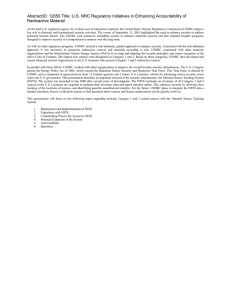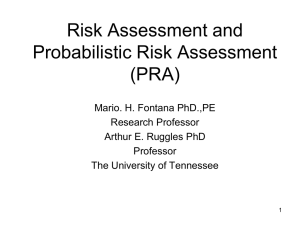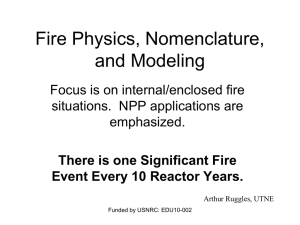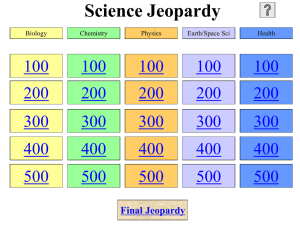Basics of FT and ET analysis
advertisement
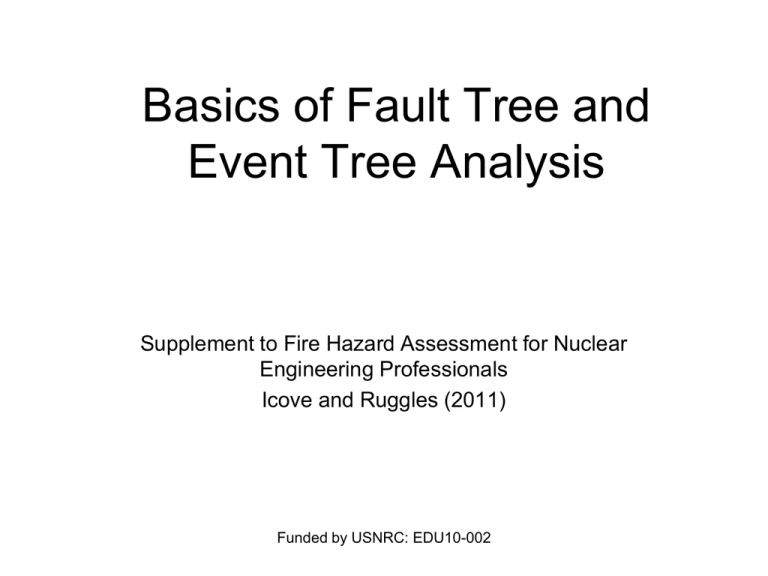
Basics of Fault Tree and Event Tree Analysis Supplement to Fire Hazard Assessment for Nuclear Engineering Professionals Icove and Ruggles (2011) Funded by USNRC: EDU10-002 Definition of Risk • Risk = Probability of occurrence x consequences. We will focus on Core Damage, or Large Early Release as consequences. • PRA models are normally consequence specific. Funded by USNRC: EDU10-002 Total Risk = Σpici Total risk would include releases, core damage, and others. Funded by USNRC: EDU10-002 Probability • Probability is a way to predict stochastic events • Common events: probability fairly well known. (e.g., MOCV failure rate, lots of data) • Rare events: Less well known. Much less data. • New Systems and Components: No data… Funded by USNRC: EDU10-002 Consequences • Conseqences from nuclear reactor accidents could be – damage to plant – Impact to environment – Loss of land use – Cost of evacuations, sheltering, etc – Health (morbidity) effects – Life threatening effects Funded by USNRC: EDU10-002 Fault Trees • Fault trees are used to determine the probability of a “top event” (e.g., core damage). • Top event defines the failure or success of a system or component • Fault tees use a structure of logical operations to calculate the probability of the top event as a result of “basic events” inputs Funded by USNRC: EDU10-002 Fault Trees (2) • The undesired event is stated at the top of the tree • The fault tree gates specify logical combinations of basic events that lead to the top event • Fault trees can be used to identify system weaknesses Funded by USNRC: EDU10-002 Fault Trees (3) • Fault trees can help recognize interrelationships between fault events • Fault trees consist of logic gates and basic events as inputs to the logic gates • Logic Gates: Boolean operations (union or intersection) of the input events • Basic Events: Faults such as a hardware failure, human error, or adverse condition Funded by USNRC: EDU10-002 AND Gate • Event 6 and event 7 must occur to “pass” the gate. P(Q) =P(A)*P(B) Funded by USNRC: EDU10-002 Amplifier Failure Mode Probabilities, NUREG 0492 Funded by USNRC: EDU10-002 Probabilities add for the OR gate, since either input, or both, will pass failure through. P(Q)=P(A)+P(B) Funded by USNRC: EDU10-002 Basic event • Basic events provide input to the fault tree, such as failure of a component or system, expressed as a probability. The circle indicates that no further development is necssary Basic event 1 1.000E-2 EVENT-1 Basic event 2 1.000E-2 EVENT-2 Funded by USNRC: EDU10-002 Additional Gates (SAPHIRE) ADDITIONAL GATES --E-- 2 3 GATE-7-0 N/M Gate (2 out of 3) EVENT-7-1 EVENT-7-1 INHIBIT Gate --E-- 8 TRANS-7-2 TRANSFER Gate EVENT-7-3 HOUSE Event Funded by USNRC: EDU10-002 --E-EVENT-7-4 UNDEVELOPED Event Steps to building a fault tree • Identify a top event as a failure to perform a function (system, component, or human failure, for example) • Identify events that could contribute to failure of the top event (usually logic gates) • Identify further “lower level” events that could contribute to the intermediate event Funded by USNRC: EDU10-002 Steps to building a fault tree (2) • Continue until reach basic events, which comprise inputs (such as component failures) to the tree • Saphire then will perform the calculations Funded by USNRC: EDU10-002 Outputs from Saphire Calculations • Calculate failure probability of top event • Calculate failure probability of intermediate events • Identify cut sets – Cut set is a sequence of events that proceed from the basic event to the top event in an unbroken sequence – Minimal cut sets are cut sets that contain minimal number of events that are not contained in other cut sets. Funded by USNRC: EDU10-002 Outputs from Saphire calculation (2) • Provide importance factors that indicate relative importance of Basic events • e.g, RIR, Risk increase ratio: Ratio of top event failure probability with a given Basic event failure probability set to 1 (“guaranteed failure”) and the rest remaining at their baseline value. • There are several other measures not included in this introduction. Funded by USNRC: EDU10-002 Outputs from Saphire calculation (3) • Calculate uncertainty of top event failure probability given uncertainty distributions of the basic events. • Usually calculations are done with point probability values (no distribution) but others can be done with different inputs – Normal, log normal, uniform, histogram, many others Funded by USNRC: EDU10-002 Cut Sets • A cut set is the path by which one or more basic events lead to the top event. • For example, – a one element cut set identifies where failure of one basic event causes failure of the top event – a two element cut set shows how failure of two basic events cause failure of the top event • Obviously, one element cut sets should be avoided. (Like one bolt holding on a wing of an airplane – one failure causes one disaster.) Funded by USNRC: EDU10-002 Cut sets (2) • Minimal cut sets are the smallest set of events that can cause failure of the top event. Cut sets that contain events already contained in a smaller set are discarded. What’s left are minimal cut sets. Funded by USNRC: EDU10-002 Larger Model Engine fails to start CLASS-DEMO Internal fuel pump damage 1.000E-2 EVENT-F.4 Fuel supply fails Ignition fails Starter inoperable GATE-F.1 GATE-IG-1 GATE-S.1 No gas in tank Fuel injection failure Battery fails GATE-F.2 EVENT-IG.1 1.000E-2 1.000E-2 EVENT-F.7 Battery fails 1.000E-2 Spark plug wire no 3 fails GATE-F.3 EVENT-IG-5 1.000E-2 Gasoline not free of gunk 1.000E-2 EVENT-F.5 2 EVENT-IG.2 Fuel injectors fouled 1.000E-2 EVENT-IG.1 Spark plugs wires or plugs failed Distributor system fails Battery fails 1.000E-2 4 GATE-1G.2 Spark plug wire 1 fails 1.000E-2 EVENT-IG.3 Starter fails 1.000E-2 EVENT-IG.1 Spark plug wire no 2 fails 1.000E-2 EVENT-IG.4 EVENT-S.1 Spark plug wire no 4 fails 1.000E-2 EVENT-IG.6 Gasoline filter failed 1.000E-2 EVENT-F.6 Funded by USNRC: EDU10-002 CLASS-DEMO - Demonstration for class 2007/09/24 Page 1 Cut sets Engine fails to start CLASS-DEMO Internal fuel pump damage 1.000E-2 EVENT-F.4 Fuel supply fails Ignition fails Starter inoperable GATE-F.1 GATE-IG-1 GATE-S.1 No gas in tank Fuel injection failure Battery fails GATE-F.2 EVENT-IG.1 1.000E-2 1.000E-2 EVENT-F.7 Battery fails 1.000E-2 Spark plug wire no 3 fails GATE-F.3 EVENT-IG-5 1.000E-2 Gasoline not free of gunk 1.000E-2 EVENT-F.5 2 EVENT-IG.2 Fuel injectors fouled 1.000E-2 EVENT-IG.1 Spark plugs wires or plugs failed Distributor system fails Battery fails 1.000E-2 4 GATE-1G.2 Spark plug wire 1 fails 1.000E-2 EVENT-IG.1 Spark plug wire no 2 fails 1.000E-2 EVENT-IG.3 Starter fails 1.000E-2 EVENT-IG.4 EVENT-S.1 Spark plug wire no 4 fails 1.000E-2 EVENT-IG.6 Gasoline filter failed 1.000E-2 EVENT-F.6 CLASS-DEMO - Demonstration for class 2007/09/24 Funded by USNRC: EDU10-002 Page 1 EVENT TREES • Event trees start with an initiating event, branch to the right as various safety functions are questioned for success (up) or failure (down) (ref Saphire manual) • Event trees – Identify accident sequences – Identify safety system functions – Quantify sequence frequencies Funded by USNRC: EDU10-002 EVENT TREE DEVELOPMENT Plant familiarization Define safety functions and success criteria Select initiating events Determine plant response Define accident sequences & plant damage states Identify system failure criteria Develop fault trees & link to event tree Funded by USNRC: EDU10-002 EVENT TREE TERMINOLOGY • Initiating event • Top event – Safety systems intented to respond to the initiating event • Branching – Underneath a top event – Up= success, Down= failure • Pass – No branch beneath a top event • Sequence – Branching path, initiating event to end state • End states – consequences and probabilities Funded by USNRC: EDU10-002 Event tree- Reactor Loss of Offsite Power Loss of offsite power initiating Emergency core cooling system Containment system LOSP ECCS CCS # END-STATE-NAMES 1 OK-NO-RELEASE 2 SOME-LATE-RELEASE 3 MEDIUM-LATE-RELEASE 4 LARGE-EARLY-RELEASE EVENT TREE LOSP - 2007/10/07 Funded by USNRC: EDU10-002 Page 2 Emergency Core Cooling System Fault Tree (ECCS) Emergency core cooling system ECCS Loss of heat sink 1.000E-2 EVENT-ECCS-1 Loss of diesel power Loss of water source 1.000E-2 EVENT-ECCS-2 1.000E-2 EVENT-ECCS-3 Funded by USNRC: EDU10-002 ECCS - Emergency core cooling system 2007/10/09 Page 1 Summary • Risk assessment is a powerful tool for – Forcing disciplined approach to analysis of safety issues – Forcing understanding of the system being evaluated – Providing methods for estimating modes of failures – Providing methods for estimating probabilities of failures – Identifying areas where more information is needed – Identifying acceptability and/or areas needing improvement Funded by USNRC: EDU10-002
